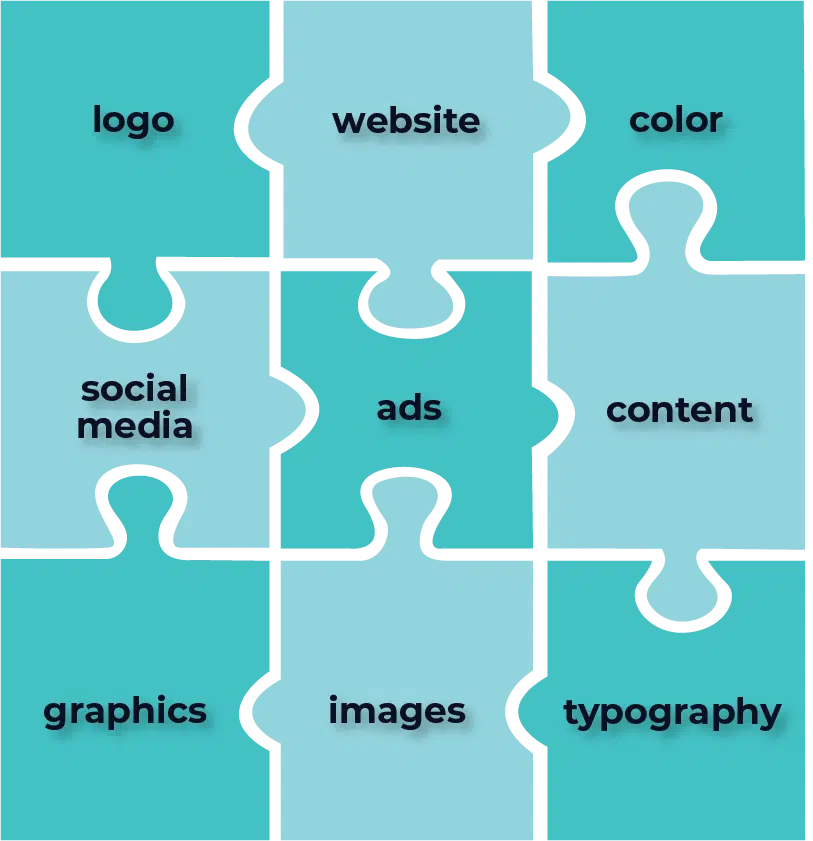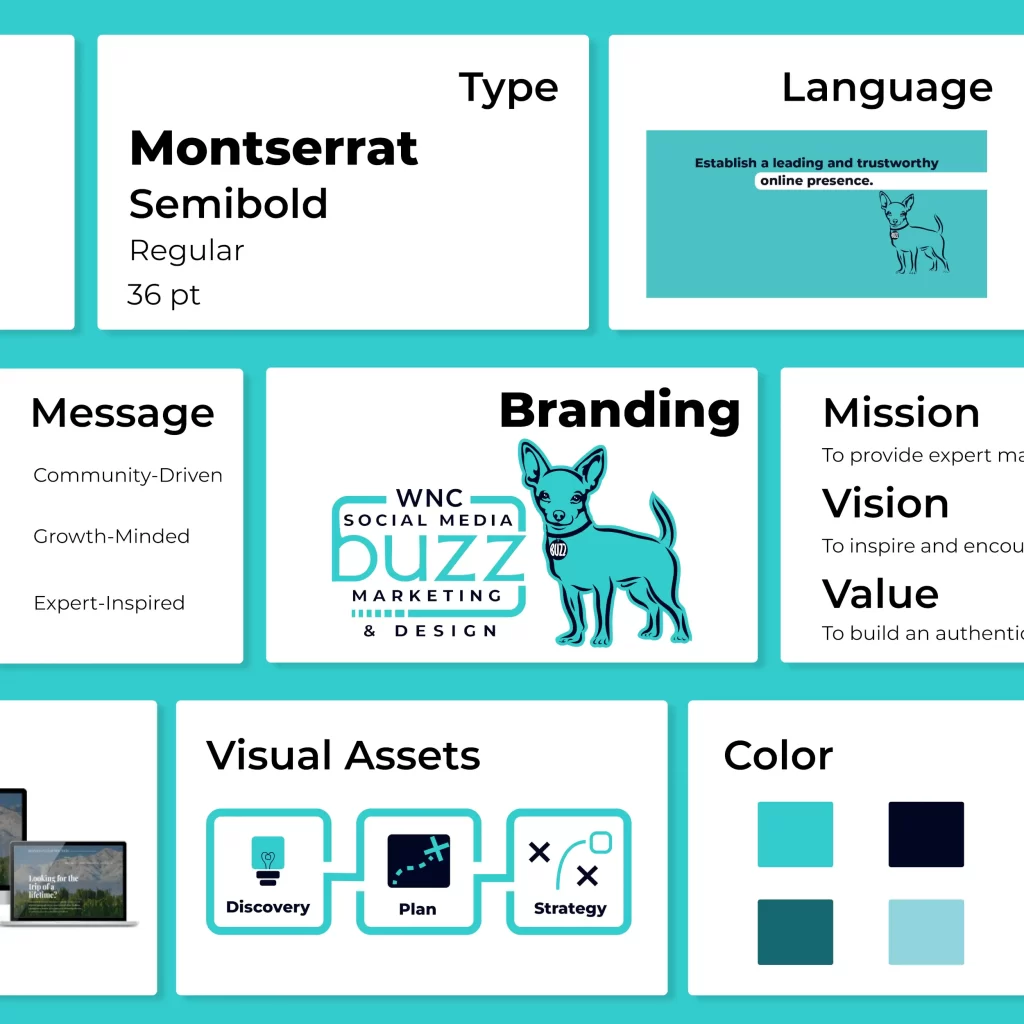As a Digital Marketing Company, we have seen it all. Many businesses and entrepreneurs have come to us asking for help with their online presence, and most believe that all they need is a logo and a website to get started. While they are crucial elements of branding, it is not all that encompasses it. Let’s review why branding is much more than a logo and website and the importance of a comprehensive branding strategy.

Branding
First, let’s define branding. Branding is creating a unique name, image, and reputation for your business. It involves everything from your:
- Logo
- Website
- Colors
- Social Media Presence
- Advertising
- Content
- Graphics
- Images
- Typography
A strong brand is essential to building trust and loyalty with your customers, standing out from the competition, and, ultimately, growing your business. Your branding should reflect your company’s personality, values, and mission. Your brand’s messaging should be consistent across all platforms, from social media to email marketing campaigns.
Colors
The colors that you choose play a significant role in creating a brand’s personality, tone, and identity. Different colors evoke different emotions and associations in people, making it essential to choose colors that align with your brand’s values and mission.
- Blue is often linked with trust and reliability.
- Red is associated with excitement and passion.
- Green typically evokes feelings of nature and harmony.
- Purple is seen as the color of royalty and creativity.
- Black conveys sophistication, power and elegance.
- White is viewed as being pure, innocent and simple.
Consistency in using your brand’s colors across all branding materials, from your logo to your website and advertising, can help to build brand recognition and create a strong visual identity. By selecting the right colors for your brand, you can create lasting impressions on your customers, increase brand awareness, and establish a unique brand identity that stands out in a competitive marketplace.
Social Media
In today’s digital age, having a strong social media presence is crucial to building a successful brand. Social media platforms allow businesses to connect and engage with their customers in real-time, making it an excellent way to promote your brand’s values and mission. A well-curated social media presence can help to establish your brand’s personality and tone and increase brand loyalty. Consistency is a major factor when it comes to social media branding – using consistent messaging, tone, and visuals across all social media channels helps to create a cohesive brand image that resonates with your audience. Social media also provides valuable insights into your customers’ behavior, preferences, and feedback, which can help to inform future branding decisions. By leveraging the power of social media, you can establish your brand as a leader in your industry, attract new customers, and build long-lasting relationships with your existing customers.
Advertising
Advertising is a way to communicate your brand’s unique selling proposition, values, and mission to potential customers. Effective advertising should be consistent with your brand’s messaging, personality, and tone to create a strong brand image. It can also help to increase brand awareness, build credibility, and differentiate your brand from competitors. By investing in targeted advertising campaigns, you can reach your ideal audience and build a positive association between your brand and the products or services you offer.
Content
Content is a critical component of a company’s branding. It includes everything from blog posts to social media captions and email marketing campaigns. High-quality content that is well-written, engaging, and informative can help to establish your brand’s voice, values, and mission. It can also help to build credibility and trust with your audience. By providing valuable content that speaks to your customers’ pain points, interests, and needs, you can position your brand as a thought leader in your industry. Content also plays a crucial role in search engine optimization (SEO), increasing your ranking in search engines and making it easier for future customers to find your brand online. By creating a content strategy that aligns with your brand’s goals and values, you can build a loyal following of customers who see your brand as a trusted source of information and solutions.
Typography
Typography is an essential aspect of a company’s branding strategy. It refers to the style and design of the text used in your logo, website, packaging, and other materials. Typography can help to convey your brand’s personality and values, creating a consistent visual identity that resonates with your target audience. Different font styles and sizes can also be used to emphasize certain aspects of your brand messaging or to create a hierarchy of information, making it easier for customers to understand and engage with your brand.
- Serif fonts are associated with traditional and classic styles. They convey a sense of elegance, formality, and professionalism.
- Sans-serif fonts are associated with modern and minimalistic styles. They convey a sense of simplicity, clarity, and informality.
- Script fonts are associated with elegance, beauty, and femininity. They often mimic handwriting or calligraphy and convey a sense of personalization and creativity.
- Bold fonts are associated with strength, power, and importance. They are often used for headlines and emphasize important messages.
- Italic fonts are associated with emphasis, movement, and elegance. They are often used for emphasis within body text and convey a sense of energy and movement.
- Handwritten fonts are associated with personalization, creativity, and informality. They are often used for invitations, greeting cards, and social media graphics
By investing in typography that aligns with your brand’s messaging and values, you can create a strong and effective branding strategy that stands out from the competition and resonates with your target audience.
Graphics
Graphics are another critical component of a company’s branding. They can include anything from product packaging and brochures to social media graphics and digital ads. Graphics can help to convey your brand’s personality and values visually, creating an emotional connection with your audience. They can also help to make your brand more memorable and recognizable, especially when they incorporate your brand’s colors, logo, and other visual elements. High-quality graphics can also make your brand appear more professional and trustworthy, increasing the likelihood that customers will choose your products or services over your competitors. By investing in quality graphics that align with your brand’s messaging and goals, you can create a cohesive and effective branding strategy that sets your business apart from the competition.
Images
Images are an essential element of a company’s branding strategy. They can include photographs, illustrations, and other visual elements that help to tell your brand’s story and convey its values and personality. Images can help to make your brand more relatable and human, creating an emotional connection with your audience. High-quality images can also make your brand more visually appealing, which can help to draw in potential customers and keep them engaged with your brand. They can be used across a range of platforms, from your website and social media to your advertising and product packaging, helping to create a consistent visual identity that reinforces your brand’s messaging and values. By investing in quality images that align with your brand’s goals and values, you can build a strong and effective branding strategy that resonates with your target audience.
Growing Your Business
So what have we learned? A logo and website are essential branding elements, but they are not the only ones. A comprehensive branding strategy involves everything from your logo and website to your customer service, social media presence, and advertising. When these elements work together perfectly, you’ll have a cohesive and effective branding strategy to help you stand out from the competition, build trust and loyalty with your customers, and, ultimately, grow your business.

